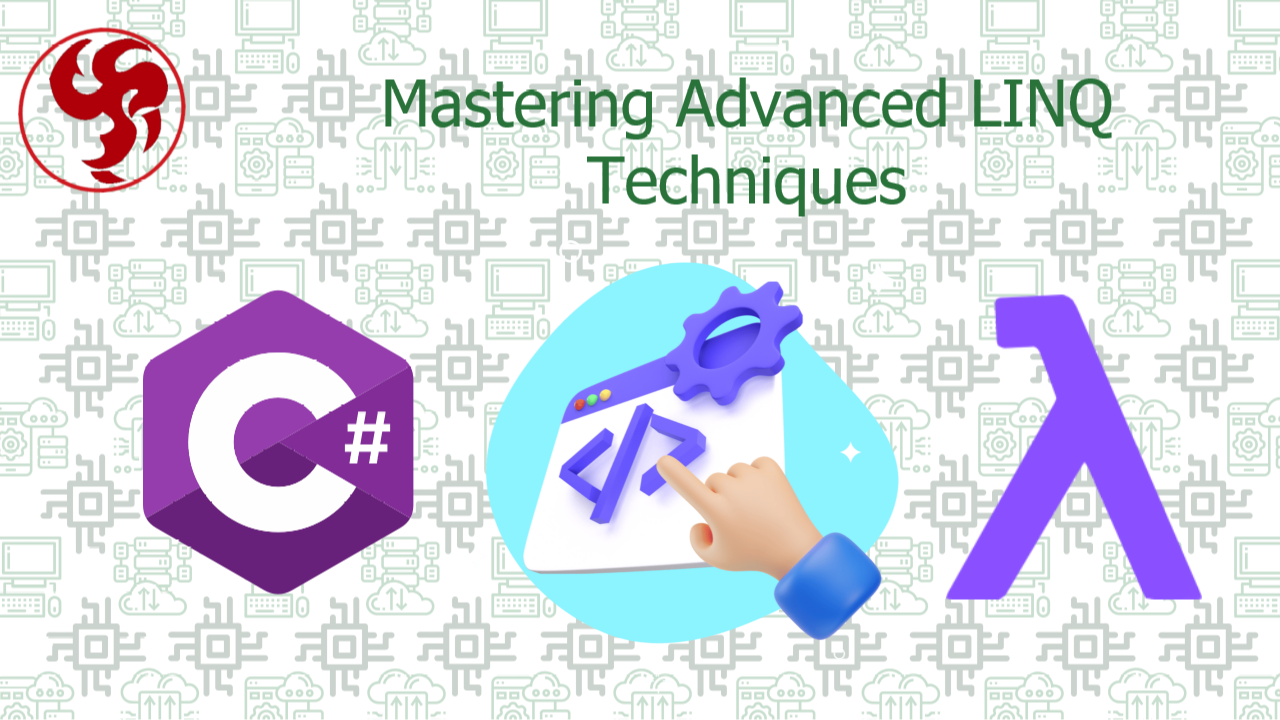Mastering Advanced LINQ Techniques
Introduction to LINQ
Language Integrated Query (LINQ) is one of the most powerful and versatile features in C#, revolutionizing how developers interact with data. Unlike traditional querying methods that require separate syntax for different data sources (SQL for databases, XPath for XML, loops for collections), LINQ provides a unified, declarative way to query and manipulate data across various sources—whether it’s in-memory collections (List<T>, arrays), databases (Entity Framework, SQL), or XML documents.
LINQ was introduced in .NET Framework 3.5 (2007) and has since become an indispensable tool for C# developers. Its key strengths include:
Readability: LINQ queries are expressive and resemble natural language, making them easier to understand than nested loops or complex SQL strings.
Type Safety: Since LINQ is integrated into C#, the compiler checks for errors at compile time, reducing runtime exceptions.
Flexibility: LINQ supports filtering, sorting, grouping, joining, and aggregating data with minimal code.
While most developers are familiar with basic LINQ operations like Where(), Select(), and OrderBy(), LINQ’s true power lies in its advanced capabilities. In this article, we’ll explore three advanced LINQ techniques:
Custom Aggregators – Going beyond
Sum()andAverage()to create specialized aggregations.Complex Projections – Shaping data into custom structures, including anonymous types and multi-source joins.
Lazy Evaluation & Performance Optimization – Understanding deferred execution and how to optimize LINQ for large datasets.
By mastering these techniques, you can write more efficient, maintainable, and scalable C# applications.
1. Custom Aggregators in LINQ
Understanding Aggregation in LINQ
Aggregation refers to the process of computing a single result from a collection of values. Common built-in LINQ aggregators include:
Sum()– Calculates the total of numeric values.Average()– Computes the mean value.Min()/Max()– Finds the smallest or largest value.Count()– Returns the number of elements.
However, real-world scenarios often require more sophisticated aggregations, such as:
Weighted averages.
Conditional sums (e.g., sum only even numbers).
Custom statistical operations (e.g., variance, standard deviation).
The Aggregate() Method
The Aggregate() method is the most flexible way to implement custom aggregations. It works by iterating over a collection and applying a user-defined accumulation function.
Syntax:
seed: The initial accumulator value.func: A function that updates the accumulator with each element.resultSelector(optional): Transforms the final accumulator into the desired result.
Example 1: Sum of Even Numbers
Here, the accumulator (acc) starts at 0, and only even numbers are added.
Example 2: Custom String Concatenation
Advantages of Aggregate()
Flexibility: Can implement any custom logic.
Powerful for complex accumulations: Useful for financial calculations, statistical operations, and custom string manipulations.
Disadvantages of Aggregate()
Verbosity: Requires more code than built-in methods.
Readability: May be harder to understand for beginners compared to simple
Sum()orAverage().
Real-World Use Case: Calculating Weighted Averages
Suppose you have a list of products with prices and quantities sold, and you want to compute the total revenue:
2. Complex Projections with LINQ
What Are Projections?
A projection transforms data from one shape to another. The simplest projection is Select(), which extracts specific properties:
However, real-world applications often require more complex transformations.
Anonymous Types for Ad-Hoc Projections
Anonymous types allow creating temporary objects without defining a class. They are useful for shaping query results.
Example: Projecting Person into Name and Age
Output:
Multi-Source Joins and Projections
LINQ allows joining multiple collections and projecting combined results.
Example: Joining People and Orders
This is similar to SQL joins but fully integrated into C#.
Advantages of Complex Projections
Reduces memory usage: Instead of loading entire objects, you fetch only needed fields.
Improves readability: Queries clearly express intent.
Enables dynamic shaping: Anonymous types adapt to varying requirements.
Disadvantages
Anonymous types are compile-time only: Cannot be returned from methods (use tuples or DTOs instead).
May lead to overly complex queries: Break down very large projections into smaller steps.
Real-World Use Case: Reporting Dashboard
Suppose you need a report combining customer data with their latest order:
3. Lazy Evaluation and Performance Optimization
What Is Lazy Evaluation?
LINQ queries use deferred execution, meaning they don’t execute until iterated (e.g., via foreach or ToList()).
Example:
When to Use Lazy Evaluation
✅ Efficiency: Avoids processing unnecessary data (e.g., if you Take(5) early).
✅ Chaining queries: Multiple operations (filter → sort → project) optimize into a single pass.
When to Avoid Lazy Evaluation
❌ Multiple enumerations: If you iterate the same query twice, it re-executes. Use ToList() to cache results.
❌ Database queries: Some ORMs (like Entity Framework) need ToList() to close connections properly.
Performance Tips
Use
AsQueryable()for databases: Lets EF Core translate LINQ to SQL efficiently.Avoid
Count()for existence checks: PreferAny()(it stops at the first match).Batch operations: For large datasets, use
Skip()/Take()for pagination.
Real-World Use Case: Streaming Large CSV Files
Conclusion
LINQ is more than just a querying tool—it’s a fundamental part of modern C# development. By mastering:
✔ Custom aggregators (via Aggregate()),
✔ Complex projections (anonymous types, joins),
✔ Lazy evaluation (performance optimization),
you can write cleaner, more efficient, and more maintainable code. These techniques are invaluable in data-intensive applications, financial systems, and real-time analytics.
Final Recommendations
Use LINQ for readability: Favor it over manual loops where applicable.
Profile performance: If a query is slow, check SQL translation (for EF) or use
ToList()strategically.Explore more LINQ methods:
GroupBy,Zip, andToLookupoffer even more power.
By embracing advanced LINQ, you unlock the full potential of C# as a data-processing powerhouse. 🚀
